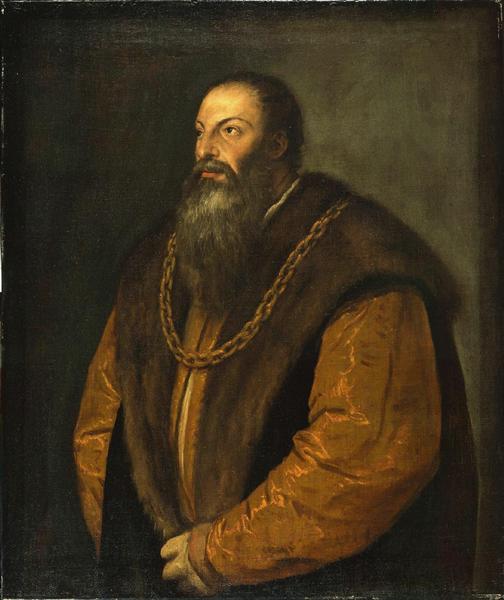Beskrivelse
In 1548, Tiziano Vecellio, known as Titian, created one of his most iconic works: the "Portrait of Pietro Aretino". This painting is a masterful example of Renaissance portraiture, capturing not only the appearance of the individual portrayed, but also his essence and character, elements that Titian handled with unparalleled mastery. Pietro Aretino, the sitter, was a renowned Italian poet, playwright and art critic of the time, famous not only for his wit but also for his influence on the culture of his time.
The composition of the work is characterised by a remarkable focus on the sitter. Aretino is presented in close-up, allowing the viewer to immediately connect with his penetrating gaze. The facial features are intensely expressive; the surface of the skin, rich in hues, is treated with a technique that seems to infuse vitality and character. Titian endowed Aretino with an aura of authority and dynamism, symbolising both his position in society and his vibrant personality. The use of light and shadow is fundamental in the work, creating a three-dimensional effect that accentuates the strength of his presence.
Colour plays a crucial role in the portrait. Titian is known for his mastery of colour, and in this work, rich shades of brown and red dominate Aretino’s clothing, contrasting with a dark background that highlights the central figure. The choice of these colours not only enriches the visual composition, but can also be interpreted as a metaphor for the complexity of Aretino as a person. The use of shadow and chiaroscuro manages to accentuate the facial features, giving it an almost sculptural air, while the draping of the clothing suggests a fluidity that amplifies its presence.
Portraiture often becomes a vehicle through which power relations and individuality in Renaissance society are explored. Aretino, being a keen critic of his time, was at the centre of the cultural and political dynamics of the period, and his depiction by Titian could be seen as an acknowledgement of his influence. Yet there is a complex mix of pride and melancholy in Aretino's face, a reflection of the burden that comes with being a "man of letters" in a period of great social and political upheaval.
Furthermore, this work fits into a broader context of contemporary portraits of literary and artistic figures, where other masters such as Raphael and Parmigianino also explored the dignity and psychology of their sitters. However, the "Portrait of Pietro Aretino" stands out for its attention to detail and the deep emotional connection it establishes between the sitter and the viewer.
Titian not only captures Aretino's physiognomy, but also inscribes his legacy on the canvas. The combination of masterful technique and deep psychology has allowed this portrait to endure over time not only as a work of art but as a commentary on the intersection between art, literature and power. Thus, the "Portrait of Pietro Aretino" stands as a powerful representation that invites reflection on the intimacy of the portrait as an artistic form and its ability to encapsulate human complexity.
KUADROS ©, a famous painting on your wall.
Hand-made oil painting reproductions, with the quality of professional artists and the distinctive seal of KUADROS ©.
Painting reproduction service with satisfaction guarantee. If you are not completely satisfied with the replica of your painting, we will refund 100% of your money.

